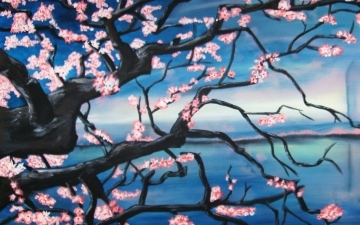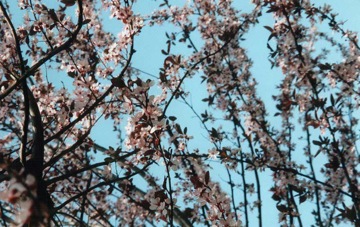Prunus serrulata or Japanese Cherry; also called Hill Cherry, Oriental Cherry or East Asian Cherry, is a species of cherry native to Japan, Korea and China. It is known for its spring cherry blossom displays and festivals.
Prunus serrulata is a small deciduous tree with a short single trunk, with a dense crown reaching a height of 8–12 metres (26–39 ft). The smooth bark is chestnut-brown, with prominent horizontal lenticels. The leaves are arranged alternately, simple, ovate-lanceolate, 5–13 cm long and 2.5–6.5 cm broad, with a short petiole and a serrate or doubly serrate margin. At the end of autumn, the green leaves turn yellow, red or crimson.
The flowers are produced in racemose clusters of two to five together at nodes on short spurs in spring at the same time as the new leaves appear; they are white to pink, with five petals in the wild type tree. The fruit is a globose black drupe 8–10 mm diameter.
Prunus serrulata is widely grown as a flowering ornamental tree, both in its native countries and throughout the temperate regions of the world. Numerous cultivars have been selected, many of them with double flowers with the stamens replaced by additional petals.
In cultivation in Europe and North America, it is usually grafted on to Prunus avium ‘Wild Cherry’ roots; the cultivated forms rarely bear fruit. It is viewed as part of the Japanese custom of Hanami.
The National Cherry Blossom Festival is a spring celebration in Washington, D.C., commemorating the 1912 gift of Prunus serrulata Japanese cherry trees from Tokyo to the city of Washington. They are planted in the Tidal Basin park.
Hanami (花見?, lit. “flower viewing”) is the Japanese traditional custom of enjoying the beauty of flowers, “flower” in this case almost always meaning cherry blossoms or ume blossoms.[1] From the end of March to early May, sakura bloom all over Japan,[2] and around the first of February on the island of Okinawa.[3] The blossom forecast(桜前線 sakurazensen?, literally cherry blossom front) is announced each year by the weather bureau, and is watched carefully by those planning hanami as the blossoms only last a week or two. In modern-day Japan, hanami mostly consists of having an outdoor party beneath the sakura during daytime or at night. Hanami at night is called yozakura (夜桜?, literally night sakura). In many places such as Ueno Park temporary paper lanterns are hung for the purpose of yozakura. On the island of Okinawa, decorative electric lanterns are hung in the trees for evening enjoyment, such as on the trees ascending Mt. Yae, near Motobu Town, or at Nakajin Castle.
(From Wikipedia, 16 July 2011)
—





